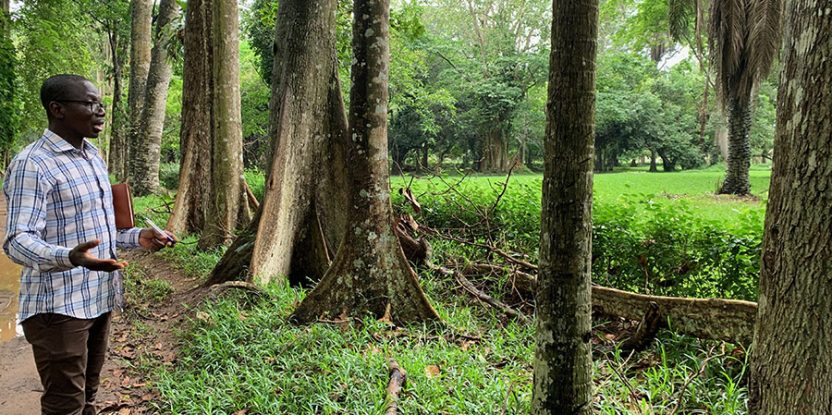
In recent decades, Cote d’Ivoire’s botanic gardens and reserves have been woefully overlooked. But that is changing: recognition of the value of botany and the importance of rare and endangered species is on the rise.
Endorsement is coming from the highest echelon. At a rally in 2023 launching the restoration of a precious but degraded forest called Divo Botanical Reserve, the Minister of Water and Forests, Laurent Tchagba, said: “The objective is to reconstitute the forest. It is a refuge for species that have disappeared. It is imperative that it be in the network of African botanical reserves.”
Divo Botanical Garden is one of seven botanical entities that were identified to be part of the Growing threatened trees’ restoration capacity in Cote d’Ivoire’s cocoa landscapes project, which is led by the Centre for International Forestry Research and World Agroforestry (CIFOR-ICRAF).
Funded by the UK government’s Darwin Initiative and called “Le Darwin” for short by Ivorian partners, the project is supporting these entities to join the 800-strong network of botanical gardens and plant conservation institutes that are members of project partner Botanic Gardens Conservation International (BGCI). This will give them access to grants, training, learning resources and eventual accreditation. Currently, not a single Ivorian botanical institution is a member: it is a big leap forward.
“The reason for working with botanic gardens and reserves is that Côte d’Ivoire has lost most of its forests,” said Christophe Kouame, CIFOR-ICRAF’s director for West Africa. “We know that such botanic institutions play a key role as custodians of rare, endangered, and endemic species.”
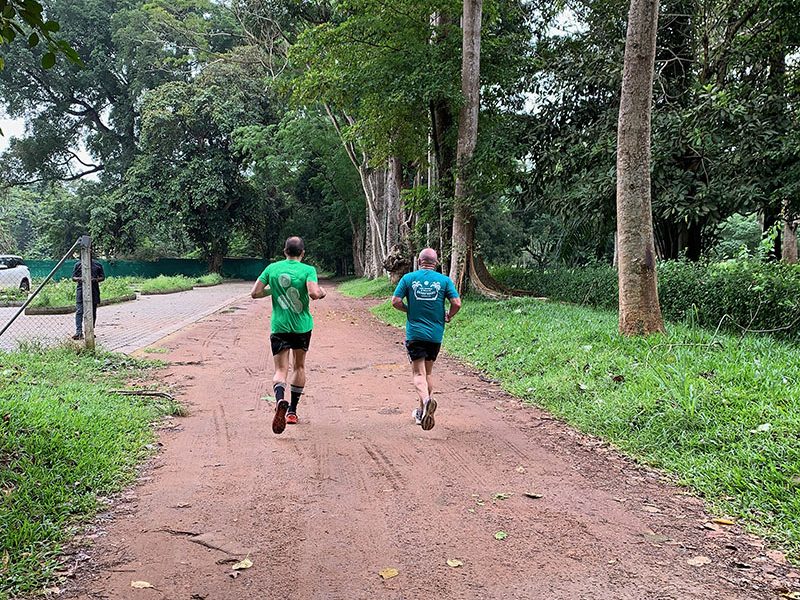
Joggers in the Botanic Garden of Bingerville. Photo by Cathy Watson/CIFOR-ICRAF
The oldest of the selected institutions is the Botanic Garden of Bingerville, which in 1904 was the site where the then Governor of French West Africa spent his leisure time: it was decreed a botanic garden in 1956, said its director Captain Gbomene Lohoué Lucas at the meeting. Today, its 56 hectares function more like a recreational park than a botanic garden, and it is frequented by runners, families, wedding parties, and tourists awed by its rows of large buttress-rooted trees. Still, managed by the Ministry of Water and Forests, well fenced and with forest rangers on patrol, it is secure from land excision and, bolstered by BGCI’s resources, could play a major role for restoration. Its tree species are a priceless botanical asset, the Ministry could oversee a floristic inventory, there is room for new collections.
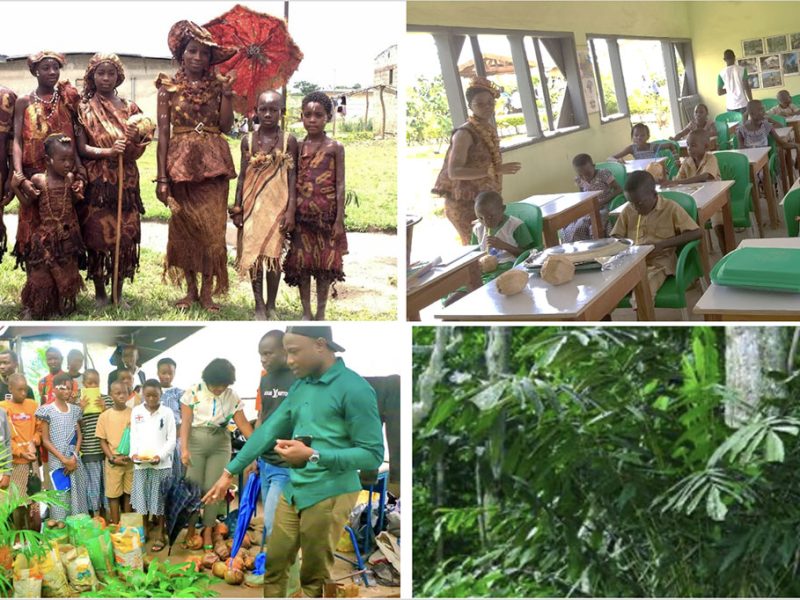
Clockwise from top left: Raffia clothing, educational events and rattan growing in the wild. Photos by Ouattara Doujdo
The newest botanical institution in the group is the Garden of Palms in the city of Divo, in the south of the country. The 0.3-hectare botanic space focuses on palms such as raffia – the leaves of which can be woven into textiles – and rattans, which are climbing palms that are economically important for making baskets and furniture.
Set up by scientists out of personal conviction, the initiative seeks “to revive biocultural traditions in danger of extinction,” according to botanist Doh Coulibaly, who added that there are 68 palm species across Africa, and 17 of these are in Côte d’Ivoire. “Only oil palm, palm nut and coconut are domesticated,” he said. “So far, we have three raffia and six rattan species in our nursery. We need to domesticate them – and all the other native palms – to stem their extinction due to deforestation and overexploitation.”
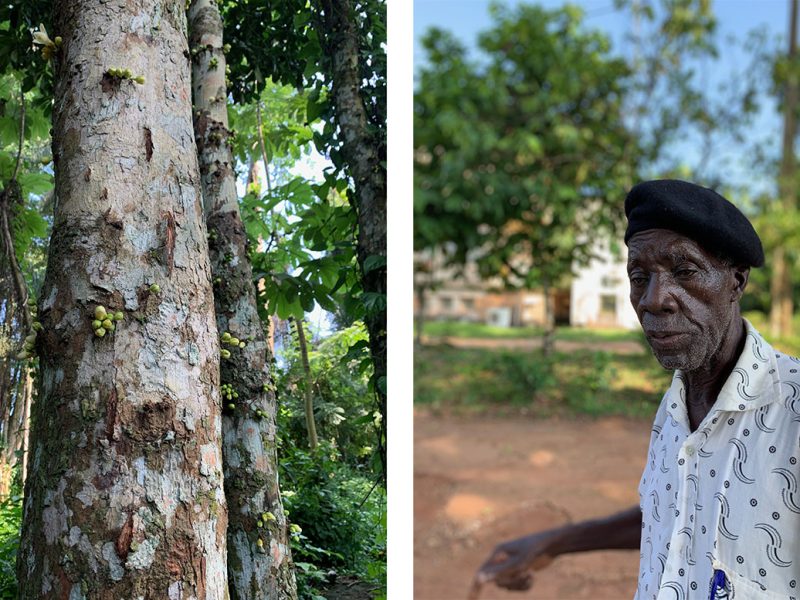
An Omphalocarpum elatim tree in Adiopodoume (left), and Téré Gnonsio (right), who began work there in 1962. Photos by Cathy Watson/CIFOR-ICRAF
The Adiopodoume Forest Reserve is a relic of the little that remains of Côte d’Ivoire’s littoral forest, and also holds 40 timber and medicinal species collected and brought there from elsewhere in the country. It has shrunk from 250 hectares in 1946 to 150 hectares today.
“What a pity. People planted cassava. This is what has happened to our botanical garden,” said Téré Gnonsio, an elderly technician who began work there in 1962 and is the custodian of the forest’s historical memory.
“This reserve has the potential to conserve species that have almost disappeared,” said Guy Gnahoua, researcher with Cote d’Ivoire’s national agricultural research centre, CNRA, on whose land the forest now sits. “There is an urgent need to fence it and obtain official status.”
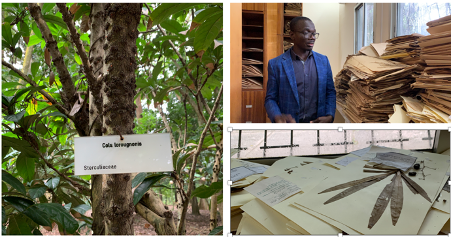
Clockwise from left: At CNF, the critically endangered Cola lourgonosis and its deputy director with pressed specimens. Photos by Cathy Watson/CIFOR-ICRAF
The National Floristic Center was created in 1974 by the famous Ivorian botanist Laurent Aké-Assi who, after receiving a doctorate in Paris, returned to Côte d’Ivoire in 1961 and set about identifying and naming – for the first time ever for science – a large number of the country’s native plants.
Today, the CNF’s botanic garden measures 10.25 hectares and has more than 600 tree species, among them the critically endangered Cola lorougnonis, which is at extremely high risk of extinction in the wild. CNF also constitutes the National Herbarium, with 29,362 specimens, pressed plants, some of which were collected by botanists from Kew Gardens and the Museum of Paris.
“We are the reference centre for the identification of plants and monitoring of the distribution of species,” said botanist Konan Yao, a researcher at CNF. High priorities for the centre going forward, he said, include establishing a fully-fledged seed bank and enriching the arboretum.
Located on the campus of the University of Félix Houphouët-Boigny, Côte d’Ivoire’s first president, CNF is a guiding star in a country where, as in most others, restoration and agroforestry projects could broaden the species they plant.
The Aké-Assi Botanical Institute of Andokoi (IBAAN) was created in 2012 and has a herbarium of nearly 10,000 pressed plant samples, a library of more than 1000 works, vegetation maps, and a garden of about 40 rare species.
At the meeting, Aké-Assi’s daughter Emma Kouassi said Aké-Assi devoted his life to the in-depth study of the natural environment. “This gave him good knowledge of the level of destruction,” she said. Current priorities at IBAAN include “identifying old undetermined collections, completing digitization, and creating a journal devoted to botanical science.”
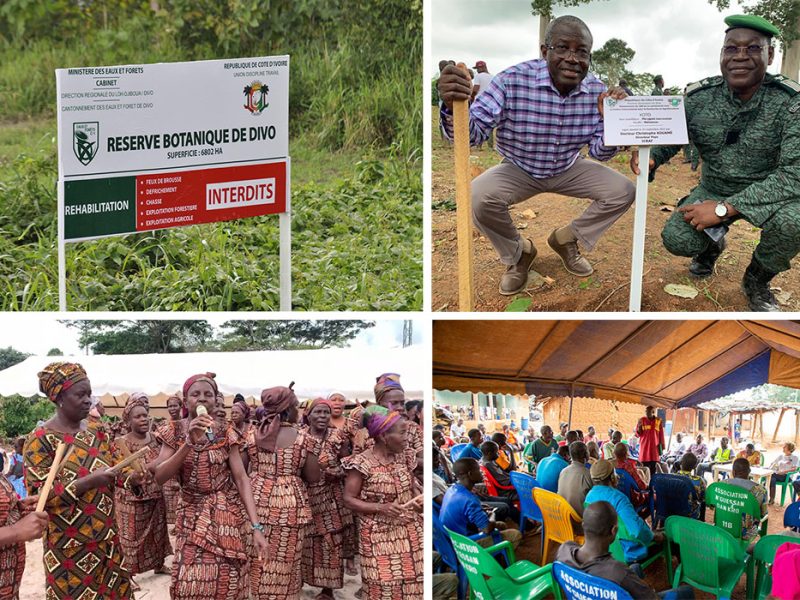
Clockwise from top left: sign marking restoration in progress at Divo Botanical Reserve; ceremonial planting by Colonel Banga and CIFOR-ICRAF’s Christophe Kouame; and community events to celebrate. Photos by Cathy Watson/CIFOR-ICRAF
Divo Botanical Reserve was created in 1975, and has been a focus for CIFOR-ICRAF since 2021 when it initiated the planting of 175,000 seedlings of 30 species within the reserves’ 6802 hectares. “It is a biodiversity heritage site that has importance at national level,” said Colonel Banga Anvoh, the director of water and forests for the Lôh-Djiboua region.
Under the ‘Growing Threatened Trees’ project, CNF led the reserve’s first known inventory, finding 595 plant species – 16 of which are threatened trees. Eight of those 16 species were represented by less than five individuals, and seven do not have propagation protocols: there is much to do.
The Centre for Forest Seed in Adzopé was created with Canadian assistance in 2000 and is run by the state company that manages classified forests, SODEFOR. “We are responsible for processing, producing and conserving the seed of forest species and their quality throughout Côte d’Ivoire,” said Second Lieutenant Diarra Fousseni, who leads the Centre. Part of the Ministry of Water and Forests, it is the only bank for forest seed in the country.
“The world’s botanic gardens conserve ex situ at least 30 percent of all known plant species, including 41 percent of all those classed as threatened. They are fundamental actors for plant conservation and ecological restoration, fighting biodiversity loss,” said Christina Coletto, head of tree conservation at BGCI, as the meeting closed, drawing the botanic garden managers’ attention to the significance of their work at planetary scale.
We want you to share Forests News content, which is licensed under Creative Commons Attribution-NonCommercial-ShareAlike 4.0 International (CC BY-NC-SA 4.0). This means you are free to redistribute our material for non-commercial purposes. All we ask is that you give Forests News appropriate credit and link to the original Forests News content, indicate if changes were made, and distribute your contributions under the same Creative Commons license. You must notify Forests News if you repost, reprint or reuse our materials by contacting forestsnews@cifor-icraf.org.